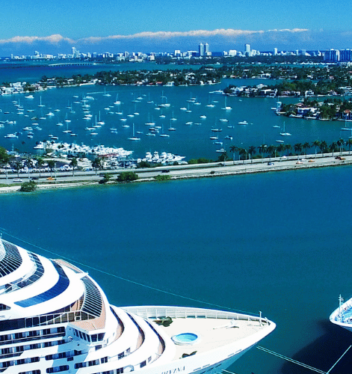The cruise industry is a vital part of the global economy, generating billions of dollars in revenue each year and supporting local economies all around the world. However, the industry has come under increasing scrutiny in recent years due to its impact on the environment and local communities. At the heart of this issue is the supply chain that supports the cruise industry, particularly Scope 3 emissions. In this article, we discuss how the cruise industry can sail towards a greener future with ATPI.
Scope 3 emissions are the indirect emissions generated by a company’s supply chain, including the production and transportation of goods, waste disposal, and air travel. In the case of the cruise industry, these emissions can account for as much as 70-85% of the total emissions, making them a crucial aspect of sustainability efforts.
To build a sustainable supply chain, the cruise industry must follow a three-step approach: measure, reduce, and offset. Some practical, relatively easy steps can be:
Measure
- Mapping out the entire supply chain: This includes identifying and assessing all suppliers and vendors involved in the production and delivery of goods and services, as well as their environmental and social impact. This way, the entire supply chain will be approached holistically for a greener future.
- Setting sustainability criteria for suppliers and partnering with those suppliers and vendors who share the same commitment to sustainability. The cruise industry can collaborate with suppliers to develop sustainability criteria and standards that are consistent with their own sustainability objectives. This can include requirements for reducing emissions, managing waste, and being socially responsible.
- Encouraging transparency and accountability: Transparency and accountability can be promoted and prioritised throughout the cruise industry’s supply chain. This can be accomplished by tracking and reporting on sustainability metrics, as well as engaging stakeholders to ensure that sustainability objectives are met for a greener future.
Reduce
- Collaborating with suppliers: The cruise industry can identify areas for improvement, as well as opportunities for innovation and collaboration, by working closely with suppliers.
- Optimise itineraries: Cruise companies can optimise their itineraries to minimize emissions from vessel operations, for example, by reducing travel distances or avoiding routes with high traffic.
- Reduce air travel emissions: Cruise companies can optimise their itineraries to reduce emissions from vessel operations, for example, by shortening travel distances or avoiding congested routes.
- Supporting sustainable innovation: The cruise industry can also contribute to sustainable innovation by investing in new technologies, solutions, and practices that reduce emissions and promote sustainability throughout the supply chain for a greener future.
Offset
- Offsetting: In cases where emissions are unavoidable, even if reduced, such as air travel, the industry can consider carbon offsetting programmes to mitigate the associated emissions.
Every aspect of the supply chain, from product manufacturing and distribution to waste disposal and travel, has the potential to have an impact on the environment and local communities. We can reduce the negative impact on the environment and communities while still supporting the industry’s growth and success by developing sustainable supply chains.
ATPI Halo
In the pursuit of a sustainable supply chain, the cruise industry has been exploring various solutions to mitigate their impact on the environment and local communities. One such solution is ATPI Halo, a CO2 measurement, reduction and offset service designed by travel management experts.
Empowering your organisation by offering maximum choice and total transparency, ATPI Halo partners with world-leading offsetting projects to support you in building sustainable travel solutions that are effective and easy to align with your corporate objectives.









